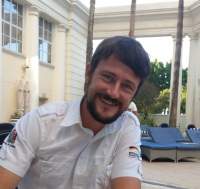- Forum
- categories
- Markets, finance and governance
- Cities (planning, implementation, and management processes)
- Pursuit of a closed nutrient cycle - New Building in Wageningen
Pursuit of a closed nutrient cycle - New Building in Wageningen
4030 views
Re: Pursuit of a closed nutrient cycle - New Building in Wageningen
Afaik, these are just plans and/or in an early stage and the reason for this approach imo also is because they want to keep it in an aquatic stage for as long as possible, so obviously no dry toilets or waterless urinals.
Edit: I've meanwhile found this PDF in Dutch www.nioo.knaw.nl/sites/default/files/Les...Learned%20NIOO_0.pdf which explains some of the installed options on the last page:
Vacuum toilets + groundwater ==> Blackwater => Biogas => effluent => algae reactor, take up P and grow
Quote:
Vacuümtoiletten verbruiken per spoeling slechts 0,5-1,0
liter water (grondwater in het geval van het NIOO),
waardoor fecaliën zo min mogelijk verdund raken;
2. Het zwarte water wordt vergist in een vergister waarbij
biogas vrijkomt. De overgebleven vloeistof gaat vervolgens
naar een algenreactor. De algen groeien en nemen
de voedingsstoffen op uit het water (waaronder fosfor);
3. De waterzuiveringscapaciteit van de algen wordt
tegelijkertijd wetenschappelijk onderzocht (medicijnresten,
hormonen, ziektekiemen, metalen).
4. Als het proces goed verloopt kan het resterende water
door het aanwezige helofytenveld worden nagezuiverd
en probleemloos in de bodem zijgen;
Eigenlijk wilde het NIOO helemaal geen rioolaansluiting,
maar het waterschap verzette zich daar hevig tegen, wijzend
op wettelijke verplichtingen. Uiteindelijk kwam het compromis
op tafel om wel een rioolaansluiting te realiseren, maar
ook de mogelijkheid om deze af te koppelen zodra het NIOO
kan laten zien dat het zelf zijn zwart afvalwater kan zuiveren.
Het mooie van de opzet is dat de genoemde algen, die slechts
leven van ons afval, CO2 en zonlicht, naderhand kunnen
worden geoogst. De algen zijn een uitstekende grondstof
voor ‘kunstmest’ of bioplastics. De proefopstelling is overigens
te klein (alleen eigen afvalwater) om commercieel algen
te kunnen oogsten, maar dat was ook niet de bedoeling. Het
NIOO zal de opstelling samen met onderzoekspartners jarenlang
monitoren, bijstellen en naar verwachting belangrijke
lessen leren, die het hopelijk marktrijp maken:
• Werkt deze C2C afvalwaterzuivering in de praktijk zoals hij
in theorie is bedacht?
• Hoe kan het systeem geoptimaliseerd worden (dimensies,
temperatuur, licht e.d.)?
• Hoe kan het systeem robuust en low-tech worden
uitgevoerd?
• Hoe kan de productie van oogstbare algen worden
opgevoerd?
• Zijn de eindproducten veilig te maken (ziektekiemen,
medicijnen, hormonen)?
• Is de werking van het helofytenfilter onder alle omstandigheden
voldoende?
So obviously there is an option to disconnect from the sewage line if their local water board agrees (same problems all over EU, imo, sigh).
Will be interesting to see their research on the algae. Maybe a case study for the SuSanA?
watsan eng.
water, sanitation, IT & knowledge management
www.saniblog.org
Toilets in Frankfurt/Main www.facebook.com/ffmtoi
Please Log in to join the conversation.
You need to login to reply- tmsinnovation
-
 Topic Author
Topic Author- Moderator
- I manage the Decentralized Wastewater Management for Adaptation to Climate Change in Jordan (ACC Project) and previously coordinated the Climate-friendly sanitation services in peri-urban areas of Lusaka project in Zambia. My background is in Management, Economics and Information Systems.
Less- Posts: 162
- Karma: 4
- Likes received: 53
Pursuit of a closed nutrient cycle - New Building in Wageningen
The Netherlands Institute of Ecology (NIOO-KNAW) just completed a new building in Wageningen, which was designed on Cradle to Cradle principles.
At 8min18sec in the video Louise Vet talks a bit about the closed nutrient cycle that they have built into the building.
It would be really interesting if someone who is more connected with the C2C scene in the Netherlands or the higher education sector in the Netherlands could see if they could find out some more details about the further research and the system that they have installed in this building.
Thoughts and comments and additional information is as always welcome!
Decentralized Wastewater Management for Adaptation to Climate Change in Jordan (ACC Project)
Project Manager
Deutsche Gesellschaft für
Internationale Zusammenarbeit (GIZ) GmbH
Ministry of Water and Irrigation, Shmeisani,
Amman
Jordan
Please Log in to join the conversation.
You need to login to reply- Forum
- categories
- Markets, finance and governance
- Cities (planning, implementation, and management processes)
- Pursuit of a closed nutrient cycle - New Building in Wageningen







